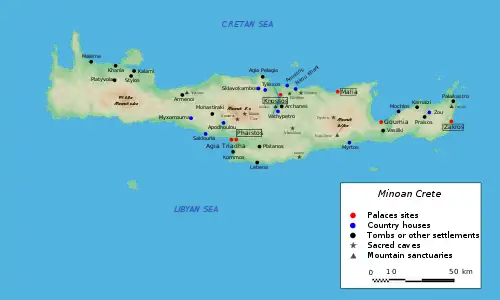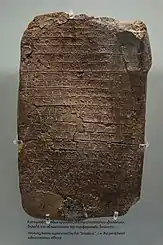
Minoan chronology is a measure of the phases of the Minoan civilization. Two systems of relative chronology are used for the Minoans. The first, based on pottery styles, divides Minoan history into three major periods: Early Minoan (EM), Middle Minoan (MM) and Late Minoan (LM). These periods can be divided using Roman numerals (e.g. EM I, EM II, EM III), which can be further divided using using capital letters (e.g. LM IIIA, LMIIIB, LM IIIC). An alternative system, proposed by Greek archaeologist Nikolaos Platon, divides Minoan history into four periods termed Prepalatial, Protopalatial, Neopalatial, and Postpalatial. Though intended as a replacement for Evans's system, the two are generally used alongside one another.
Establishing an absolute chronology has proved difficult. Archaeologists have attempted to determine calendar dates by synchronizing the periods of Minoan history with those of their better understood contemporaries. For example, Minoan artifacts from the LM IB period have been found in 18th Dynasty contexts in Egypt, for which Egyptian chronology provides calendar dates. However, dates determined in this manner do not always match the results of carbon dating and other methods based on natural science. Much of the controversy concerns the dating of the eruption of Thera, which is known to have occurred towards the end of the LM IA period. While carbon dating places this event (and thus LM IA) around 1600 BC, synchronism with Egyptian records would place it roughly a century later.[1][2][3][4][5]
| 3100–2650 BC[6] | EM I | Prepalatial |
| 2650–2200 BC | EM II | |
| 2200–2100 BC | EM III | |
| 2100–1925 BC | MM IA | |
| 1925–1875 BC | MM IB | Protopalatial |
| 1875–1700 BC | MM II | |
| 1750–1700 BC | MM III | Neopalatial |
| 1700–1625 BC | LM IA | |
| 1625–1470 BC | LM IB | |
| 1470–1420 BC | LM II | Postpalatial |
| 1420–1330 BC | LM IIIA | |
| 1330–1200 BC | LM IIIB | |
| 1200–1075 BC | LM IIIC |
Evans' chronology
Arthur Evans's chronological framework had triple divisions, each triply sub-divided, a formula that has been retained, thus Early Minoan (EM) I, II and III, Middle Minoan (MM) I, II and III etc. Each subsection he divided into A and B, early and late. In 1918 Alan J. B. Wace and Carl Blegen adapted Evans' chronology to the Greek mainland and the islands, where the culture was termed Helladic and Cycladic. In 1941 Arne Furumark applied the term Mycenaean to LH and LC. As the Mycenaean Greeks dominated at Knossos at some point in Late Minoan (LM), the latter is often included under "Mycenaean" or called "Minoan-Mycenaean".
Evans never intended to give exact calendrical dates to the pottery periods. He did correlate them roughly[7] to better dated Egyptian periods using finds of Egyptian artifacts in association with Cretan ones and obvious similarities of some types of Cretan artifacts with Egyptian ones.
The one serious question[8] concerns the date of the Knossos tablets. Allegations were made that Evans falsified the stratum in which the tablets were found to place the tablets at 1400 BCE when they ought to have been the same date as the Pylos tablets, 1200 BCE. This dispute became known as the Palmer-Boardman Dispute when it first appeared. A key part of the case was that a certain kind of vase, a stirrup jar (named from the handles) found in tablet contexts, is dated only to 1200.
Modern chronology
Beginning in the 1940s with the advent of technologies such as radiocarbon dating, and the expansion of historical knowledge of the Mediterranean region, Minoan chronologies have shifted away from Evans' purely relative system and incorporated more absolute dates.
Modern chronologies are generally divided into three primary categories that retain the general framework developed by Evans: "high chronology," methods using technological solutions such as radiocarbon dating to determine the time period of an artifact's creation, "low chronology," composed of more traditional methods relying on Minoan artifacts found in contexts that allow them to be dated, such as next to an item produced by a different civilization or in a location outside of Crete, for example Cretan pottery found in the tomb of the Egyptian Pharaoh Thutmose III.[9][10] The third modern chronological style is a combination of the two methods.[9][11]
Theran eruption

The timing of natural disasters is of importance to high and low chronologies, which can use the resulting geological evidence to date co-located artifacts. The eruption of the Thera volcano on what is now the island of Santorini is of particular significance to the chronology of Minoan history.
The Theran eruption plays a role in both the high and low chronological approaches, although there is a difference in the date range each system assigns to the event. In his initial framework, Evans vaguely assigned the eruption to the 17th century BCE.[12] Low chronological assessments revise the eruption to the mid-15th century, while high and blended chronologies push the date back to a point in between Evans' and low chronologies, a more commonly accepted specific date of approximately 1628, though the date is by no means generally agreed. The precise date is of more concern to archaeologists of the Asian mainland and Ancient Egypt, where volcanic ash from Thera is widely evident, and there are established competing chronologies, than to those of Crete.
High chronological techniques such as radiocarbon dating can be used in conjunction with evidence from artifacts indirectly related to the eruption, such as eruption-caused tsunami debris to pinpoint the exact timing of the event, and therefore which Minoan period it belongs in.[13] However, the broadness of radiocarbon dating has also resulted in dates for the eruption of Thera that do not precisely match evidence from the archeological record.
Palaces of Crete and the palatial periods

The island of Crete is home to several palaces constructed by the Minoan civilization, all of which are archeologically significant. The primary palaces were located at Knossos, Malia, and Phaistos.[14] Each palace was constructed and rebuilt multiple times on the same sites. The palaces' distinct construction phases are used to further divide the relative periods of the Minoan chronology system into five distinct sections: prepalatial, protopalatial, neopalatial, late palatial or the final palace period, and the post-palatial period.[14]
Prepalatial period
The prepalatial period is a broad time period, spanning from approximately 7000 to 1900, and is itself divided into neolithic, early prepalatial, and late prepalatial sections.[15] Characterized by the creation of large settlements at the locations where palaces would later be constructed and usage of early forms of the architecture later found at palatial sites, the prepalatial period contains the relative chronological divisions EM I through at least part of MM IA.[15]
Protopalatial period
The protopalatial period lasted from approximately 1900 until 1750, or in the relative chronology MM IB through MM IIB.[16] The major palaces' completion occurred during this time-frame, distinguished by distinct ashlar masonry with marks created by the responsible masons. The protopalatial phase also saw the emergence of both the Linear A and Cretan hieroglyphic writing systems, although they likely initially saw use as early as the end of the previous period.[16][15]
Neopalatial period
The neopalatial period occurred during the relative chronological divisions of MM III and LM IB, a roughly 260-year span between 1750 and 1490[17] The period is represented by the dramatic expansion and reconstruction of the palace at Knossos, associated with Evans' discoveries of paintings featuring bulls, which he interpreted as evidence for the existence of the Labyrinth of Greek myth. Additional palaces were built at Galatas and Zakros, while the palaces at Malia and Phaistos underwent periods of destruction, abandonment, and reconstruction.[17]
The Theran eruption occurred during the end of the neopalatial period, during the end of LM IA.[18]
Late palatial period

Beginning in the LM II period, approximately 1490, and ending with the start of the LM IIIB period 130 years later in 1360, the late palatial period was the final use of intact palace structures on Crete.[19] The palaces at Phaistos, Galatas, Zakros, and Malia were largely destroyed and/or abandoned, while the palace at Knossos received its final additions.
The late palatial period marked the emergence of the Linear B script, an early form of written Greek, used at Knossos to record economic and administrative information.[19]
Post-palatial period
The post-palatial period of Minoan chronology, a roughly 140-year period between 1360 and 1200, falls into the last relative period defined by absolute dates, LM IIIB.[20] The period saw Knossos lose prominence as a settlement, with the majority of new construction taking place at the agricultural and trade center of Mesara. The end of the post-palatial period also represented an emphasis of Mycenaean Greek styles of construction and architecture over traditional Minoan methods.
Notes
- ↑ Manning, Sturt W; Ramsey, CB; Kutschera, W; Higham, T; Kromer, B; Steier, P; Wild, EM (2006). "Chronology for the Aegean Late Bronze Age 1700–1400 BC". Science. 312 (5773): 565–569. Bibcode:2006Sci...312..565M. doi:10.1126/science.1125682. PMID 16645092. S2CID 21557268.
- ↑ Friedrich, Walter L; Kromer, B; Friedrich, M; Heinemeier, J; Pfeiffer, T; Talamo, S (2006). "Santorini Eruption Radiocarbon Dated to 1627–1600 B.C". Science. 312 (5773): 548. doi:10.1126/science.1125087. PMID 16645088. S2CID 35908442.
- ↑ "Chronology". Thera Foundation. Retrieved 2009-01-03.
- ↑ Balter, M (2006). "New Carbon Dates Support Revised History of Ancient Mediterranean". Science. 312 (5773): 508–509. doi:10.1126/science.312.5773.508. PMID 16645054. S2CID 26804444.
- ↑ Warren PM (2006). Czerny E, Hein I, Hunger H, Melman D, Schwab A (eds.). Timelines: Studies in Honour of Manfred Bietak (Orientalia Lovaniensia Analecta 149). Louvain-la-Neuve, Belgium: Peeters. pp. 2: 305–321. ISBN 978-90-429-1730-9.
- ↑ This chronology is based on Manning (2012), which gives absolute dates based on radiocarbon dating.
- ↑ "Archived copy" (PDF). oi.uchicago.edu. Archived from the original (PDF) on 6 December 2006. Retrieved 13 January 2022.
{{cite web}}: CS1 maint: archived copy as title (link) - ↑ There are many questions, of course, but this one persists and would overthrow an important part of Evans' chronology. A brief review can be found at the Stanford Archaeopedia Archived 2006-12-16 at the Wayback Machine site.
- 1 2 McEnroe, John C. (2010). Architecture of Minoan Crete : Constructing Identity in the Aegean Bronze Age. web: University of Texas Press. pp. 6, 7.
- ↑ Höflmayer, Felix (2009). "Aegean-Egyptian Synchronisms and Radiocarbon Chronology". Monographs of the Danish Institute at Athens. 10: 192. ISBN 978-87-7934-024-4.
- ↑ Housley, R.A. (1999). "Radiocarbon, Calibration, and the Chronology of the Late Minoan IB Phase". Journal of Archaeological Science. 26 (2): 159–171. doi:10.1006/jasc.1998.0312 – via Academia.edu.
- ↑ McEnroe, John C. (2010). Architecture of Minoan Crete : Constructing Identity in the Aegean Bronze Age. Web: University of Texas Press. pp. 7, 6.
- ↑ Höflmayer, Felix (2009). "Aegean-Egyptian Synchronisms and Radiocarbon Chronology". Monographs of the Danish Institute at Athens. 10: 194. ISBN 978-87-7934-024-4.
- 1 2 McEnroe, John C. (2010). Architecture of Minoan Crete : Constructing Identity in the Aegean Bronze Age. Web: University of Texas Press. pp. 9, 45, 69, 93, 117, 133.
- 1 2 3 McEnroe, John C. (2010). Architecture of Minoan Crete: Constructing Identity in the Aegean Bronze Age. Web: University of Texas Press. pp. 9, 19, 31.
- 1 2 McEnroe, John C. (2010). Architecture of Minoan Crete: Constructing Identity in the Aegean Bronze Age. Web: University of Texas Press. pp. 45–54.
- 1 2 McEnroe, John C. (2010). Architecture of Minoan Crete: Constructing Identity in the Aegean Bronze Age. Web: University of Texas Press. pp. 69–79, 81–92.
- ↑ Manning, Sturt W. (1999). A Test of Time: The Volcano of Thera and the chronology and history of the Aegean and east Mediterranean in the mid second millennium BC. Print: Oxbow Books. pp. 18, 19. ISBN 1-900188-99-6.
- 1 2 McEnroe, John C. (2010). Architecture of Minoan Crete: Constructing Identity in the Aegean Bronze Age. Web: University of Texas Press. pp. 117–120, 122, 126–130.
- ↑ McEnroe, John C. (2010). Architecture of Minoan Crete: Constructing Identity in the Aegean Bronze Age. Web: University of Texas Press. pp. 133, 136, 143.
References
- Hemingway, Seán, Art of the Aegean Bronze Age, The Metropolitan Museum of Art Bulletin, Spring 2012 Volume LXIX, Number 4 (chronology table on p. 48)
- Hutchinson, Prehistoric Crete, many editions hardcover and softcover
- Matz, Friedrich, The Art of Crete and Early Greece, Crown, 1962
- Mackenzie, Donald A., Crete & Pre-Hellenic, Senate, 1995, ISBN 1-85958-090-4
- Palmer, L. A., Mycenaeans and Minoans, multiple editions
- Platon, Nicolas, Crete (translated from the Greek), Archaeologia Mundi series, Frederick Muller Limited, London, 1966
- Vasilakis, Andonis, Minoan Crete: From Myth to History, 2000, Adam Editions, Athens, ISBN 9789605003432
- Willetts, The Civilization of Ancient Crete, Barnes & Noble, 1976, ISBN 1-56619-749-X
External links
- Ian Swindale, using the chronology of Andonis Vasilakis in his book on Minoan Crete, published by Adam Editions in 2000
- Dartmouth College
- World History Encyclopedia
- Thera Foundation
- L. Marangou in the Foundation of the Hellenic World site
- Companion to Manning (Cornell)
- University of Oklahoma